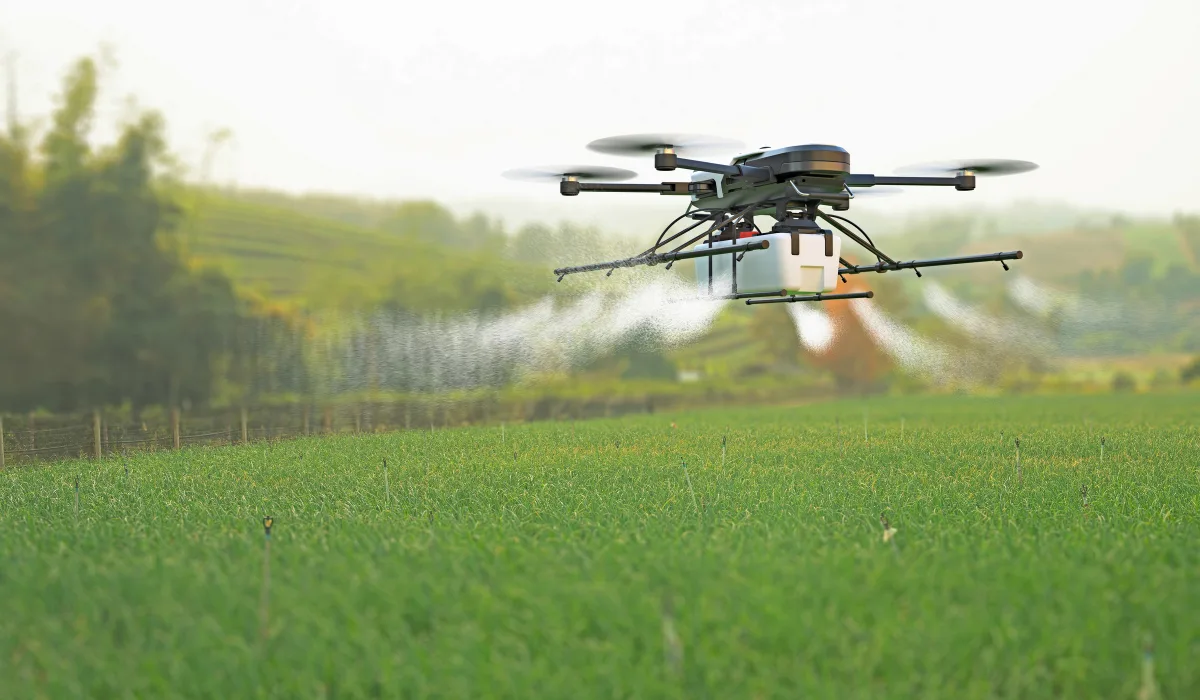Agriculture is not only a job in Uttar Pradesh's vast plains; it is the lifeblood of rural areas. Here, farming has always been quite traditional, from the early morning commotion of farmers getting bullock carts ready to the sunset view of golden fields swaying beneath the fading light. However, a silent revolution has started in recent years.
Drones are starting to blend into the rural soundscape where farmers previously only used standard tools and human labor. Once believed to be the stuff of science fiction or military applications, these flying aircraft are now softly lying over fields while carrying nano-urea, a cutting-edge fertilizer solution, instead of guns or cameras.
This change is emotional as well as technological. Drones spraying nano-urea provide "hope, efficiency, and the promise of sustainability" to farmers who have long battled weather shifts, low output, and growing prices. India's agricultural heartland, Uttar Pradesh, faces a revolution which fuses innovation and tradition, and the story is only getting started.
What is Nano-Urea & Why It Matters
We must first comprehend what nano-urea is in order to grasp why drones spraying it is such a breakthrough. Indian farmers have been relying on traditional urea, the white crystalline fertilizer that arrives in large 45 kilogram sacks, for many years. Nitrogen, a nutrient essential to crop growth, is supplied by it. The issue, however, is that plants only absorb 30–40% of this urea. The remainder is squandered, either dissolved into the air, washed into rivers, or retained in soil where it causes more harm than benefit.
The consequences are serious:
- Soil degradation, where fertile land loses its productivity.
- Water pollution, as runoff contaminates rivers and groundwater.
- Greenhouse gas emissions, worsening climate change.
- Rising costs for farmers, who need more urea every year just to maintain yields.
The Indian Farmers Fertilizer Cooperative Limited, or IFFCO, created nano-urea, which has come to the rescue in this situation. Nano-urea, which comes in a compact 500 ml container, is equivalent to a 45 kilogram bag of regular urea. Its particles of nitrogen, which are readily absorbed by plant leaves, are its secret.
Why it matters:
- lessens reliance on artificial nutrients.
- boosts the yield of crops while using fewer inputs.
- protects water and soil from excessive chemical exposure.
- greatly reduces farmers' expenses.
- backs India's sustainable agriculture objectives.
Drone spraying improves the efficacy of nano-urea by providing uniform coverage, rapid absorption, and minimal waste.
Read also: AI Drones to Watch Over Bihars Bridges
The Rise of Drones in Agriculture
Drones were once seen only in movies or used by defense forces. But today, they are becoming common in Indian agriculture.
The rise of drones in farming has been driven by multiple factors:
- Labor shortages – Seasonal migration and urban job opportunities mean fewer workers available for farm spraying.
- Cost pressures – Rising fertilizer and pesticide costs are forcing farmers to seek efficient methods.
- Government push – Subsidies and schemes encouraging agri-tech adoption.
- Technology becoming affordable – Local startups and cooperatives offering drone services at reasonable prices.
Drones are already being utilized in Uttar Pradesh for field mapping, pesticide spraying, and now nano-urea spraying. Precision farming—using technology to save time, effort, and money—is a novel idea to farmers, particularly younger ones. Drone acceptance also reflects a change in view. These days, farming is more than simply hard work; it's smart farming, where technology and expertise go hand in hand.
How Drone Spraying Works in UP Fields
The procedure is futuristic yet easy. From the field's edge, a drone that has sprayers and a liquid tank takes flight. With manual or GPS mapping guidance, it flies at low altitudes. It ensures that every plant leaf gets the nutrient by spraying a tiny mist of diluted nano-urea while it hovers above the crops.
The benefits are striking:
- Speed: One drone can spray 25-30 acres in a day, compared to just 2-3 acres manually.
- Precision: Drones cover every inch of the crop uniformly.
- Safety: Farmers avoid direct contact with chemicals.
- Water efficiency: Uses significantly less water compared to traditional spraying.
When a drone flies over verdant fields in UP villages, people get curious and proud. Farmers nod in agreement as they see how much time and effort it saves them, children pursue it with glee, and seniors observe with cautious awe.
Farmers’ Stories and Voices
Consider the case of Basti district sugarcane farmer Ramesh Yadav. Ramesh suffered for years as the expense of fertilizer reduced his earnings. "I purchased 15 to 20 bags of urea each season. The yield was not rising, however. He remembers, "The soil was becoming harder." He saw the difference, however, when his cooperative started using drone-sprayed nano-urea. "I spent a lot less money, and the plants were healthier and greener. It would have taken me two days to complete my entire field, but the drone completed it in only two hours.
Sita Devi, a female farmer from eastern Uttar Pradesh, says drones are also helpful. Fertilizer application used to be a physically demanding task that was mostly performed by males. Now, even I can handle drones. My field is ready in a few hours after I just schedule the service. These voices draw attention to a more profound shift: drones are empowering farmers on a social and economic level, going beyond efficiency.
Read also: Drone For Agriculture Use In India
Government Initiatives & Support
The Government of India and the UP state government are playing a key role in popularizing drones. The PM-Kisan Drone initiative, subsidies for drone purchase, and training programs for rural youth are making adoption easier.
In UP, agricultural universities and Krishi Vigyan Kendras (KVKs) are actively conducting demonstrations. Cooperatives like IFFCO are leading large-scale spraying drives to show farmers the benefits of nano-urea drones. By linking drones with government-backed fertilizer policies, authorities are ensuring that the technology reaches even small and marginal farmers, not just wealthy ones.
Economic Impact for Farmers
Cost reduction is one of the main benefits of using drones to spray nano-urea. A 45 kilogram bag of regular urea costs far more than a 500 ml vial of nano-urea. Farmers also save money on labor, fuel, and water when using drones.
By some estimates, farmers may increase yields by 8–10% while lowering fertilizer expenses by 30–40% per season. These figures might represent the difference between debt and profit for small farmers. Also, drone spraying creates new businesses. Jobs can be created locally by training young people from rural areas to operate drones and perform services.
Environmental & Social Benefits
The environmental advantages are enormous and go beyond economy. Reduced greenhouse gas emissions, better soils, and less groundwater pollution result from using less fertilizer. Plants are protected against chemical overload by uniform spraying. Drones help farmers, particularly women and older laborers, by lessening their physical strain. Additionally, they elevate farming by making it appear cutting edge, dignified, and modern.
Challenges in Adoption
Of course, challenges remain. Not every farmer can afford to own a drone. Awareness levels are still low in many villages. Training and maintenance are also issues. Some farmers remain skeptical—worried whether a small bottle of nano-urea can really replace a heavy bag. Others fear that technology might reduce rural employment. To overcome these, consistent demonstrations, financial support, and farmer-to-farmer learning will be critical.
Future of Smart Farming in UP & India
The use of drones for nano-urea spraying is just the beginning. Experts believe that in the coming years, drones will handle seed sowing, crop health monitoring, irrigation, and harvesting support. Combined with AI, IoT sensors, and data analytics, farming in UP could become fully precision-based. India’s vision of becoming a leader in sustainable agriculture aligns with this. As drone costs fall and nano-fertilizers gain popularity, Uttar Pradesh could set an example for the entire nation.
Read also: Latest updates on indian drone policy 2025
Conclusion – Hopeful, Visionary Wrap-Up
The image of a drone in Uttar Pradesh spraying nano-urea on a wheat or sugarcane crop signifies more than simply an economic feat. It shows the hard work of farmers, the vision of politicians, and the ability of ingenuity to solve issues that persist.
Yes, challenges exist. But the direction is clear. Less fertilizer, more yield. Less labor, more efficiency. Less harm, more sustainability.Drones provide millions of farmers in Uttar Pradesh more than just nano-urea; they also deliver dignity, optimism, and the prospect of a better farming future.













